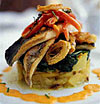About Timisoara

Timisoara is the second largest city in Romania, and an important economic centre in the western part of the country. The city was build on the site of an ancient Roman fortress, the first record dating back to the 12th century. Being under the rule of the Habsburg Empire for two centuries, most of the buildings in the city centre were built with influences from the Austrian architecture, earning Timisoara the nickname of "Little Vienna". It was the first city in Europe and the second in the world after New York, to be lit by electric street lamps in 1884.
more travel information: www.romaniatourism.com/timisoara.html

The charm of Timisoara lies in its distinct cultural life, having an impressive combination of Byzantine, baroque and later modernist architecture. Some of the city's most interesting landmarks are the elegant baroque buildings spread around the major squares of the city. A focal point is the Victory Square and the Orthodox Metropolitan Cathedral, with a memorial to the 1989 Romanian Revolution. Another touristic attraction is the Union Square and the Roman Catholic and Serbian Orthodox Cathedrals, fine examples of Viennese baroque style. The square is dominated at the south side by the impressive 18th century Baroque Palace, formely the governor's residence, now housing the Museum of Fine Arts. Timisoara also has several museums dedicated to the ethnographic specific of the Banat region.

Timisoara is an important crossroad between European and domestic destinations, and a major railway centre in Romania. The city is served by Romania's second busiest international airport, Traian Vuia. To get to the main city of Timisoara, you could use the Timisoara airport transfer service.
Timisoara uses a public transport network consisting of tram, trolleybus and bus lines, operated by the local autonomous corporation, as well as private taxi companies. There is also the option to rent a car using services offered by EuroCars. There are also limousine rental service available.

Due to the economic boom of the recent years and the increasing number of tourists, Timisoara has developed many accommodation offers, such as hotels and hostels, or by renting short and long term apartments.

Finding the appropiate dining place in Timisoara isn't difficult. A great number of restaurants and bars are available, with many of them serving traditional Romanian specialties. There are also fast foods available, as well as country specific restaurants.

As an important economic centre, Timisoara has many malls and shopping centres, as well as antiques and handicraft shops for those who seek interesting gifts or souvenirs. Most of the folk crafts are specific to the Banat region.

Timisoara is home to many musical and theatrical performances, and a buzzing nightlife. There is always the Banat Philharmonic or National Theatre for a cultural experience of Timisoara, as well as art exhibitions. Also a wide number of bars, clubs or casinos are available to those who prefer a nightly form of entertainment.
